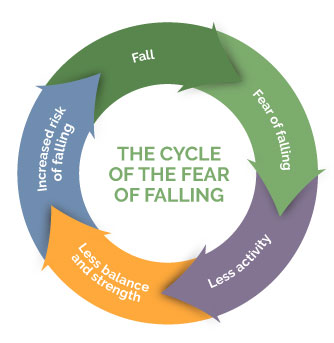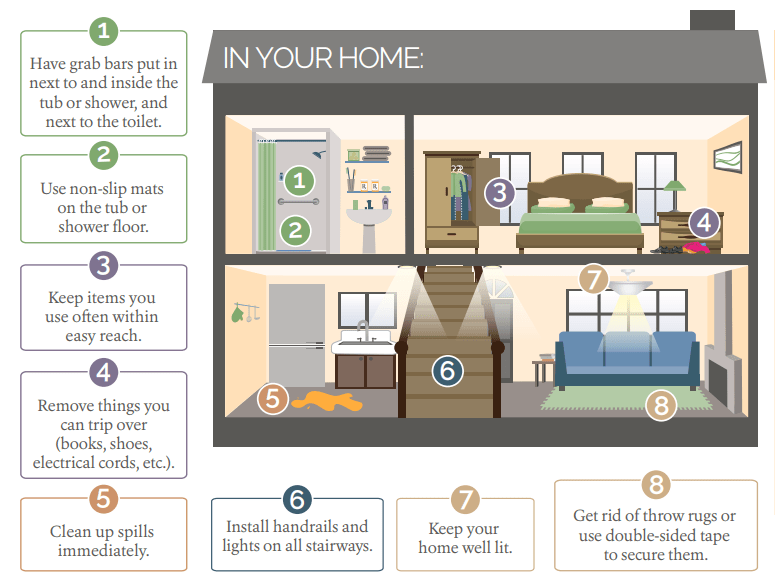Falls are common among older adults, but they aren’t a normal part of aging. Our Fall Reduction Program can help you lower your fall risk in the comfort of your own home.
FALL REDUCTION PROGRAM HIGHLIGHTS
- Evidence-based clinical practices so you receive high quality care backed by science
- Interdisciplinary approach that gives you access to a diverse team of professionals who can address your fall risk factors
- Expert care in the home, where 75% of falls happen
- Patient empowerment model that encourages you to take an active role in fall risk prevention
- Fall detection system (offered at no charge for up to 120 days while on our service) that offers safety and peace of mind
- Program developed in collaboration with renowned geriatric fall expert Michelle Lusardi, PT, DPT, PhD, FAPTA
Is home health care right for your loved one?
HOW HOME HEALTH CARE HELPS PREVENT FALLS
We help to address a range of fall hazards at home, including:
Musculoskeletal Issues
Issues with your muscles, joints, nerves, discs, blood vessels and other parts of your musculoskeletal system
Visual Disturbances
Examples include cataracts, glaucoma and vision loss
Functional and Cognitive Impairments
Examples include memory loss, loss of a limb, or difficulty walking, seeing, hearing or problem-solving
Chronic Conditions
Persistent illnesses such as Parkinson’s disease, diabetes and dementia that can affect your balance
Medications
Sleep aids, certain blood pressure medications and others that may put you off balance
Home Safety
Removing fall hazards like clutter, throw rugs and long electrical cords

Did You Know? An older adult falls every second* of every day.
FALL PREVENTION GOALS
We aim to help you:
- Understand your fall risk
- Learn healthy self-care
- Improve your quality of life
- Avoid preventable falls
- Remain safely in your home, with as much independence as possible
- Reduce expensive hospitalizations
As many as two-thirds** of falls can be prevented through evidence-based fall-reduction interventions.
IS THE AMEDISYS FALL REDUCTION PROGRAM RIGHT FOR YOU?
The Amedisys Fall Reduction Program may be right for you if you:
- Have fallen in the past year
- Feel unsteady when standing or walking
- Worry about falling
Falls include tripping or slipping as well as falling back into a chair or onto a bed when trying to get up.
99% of Amedisys home health care centers are rated 4+ Quality Stars.
WHAT COULD HAPPEN IF YOU FALL?
Falls are the number one cause of death and injuries among older adults ages 65 and over. The long-term consequences can be life-altering.
Falls have more than physical effects. Falls can trigger a crisis of confidence. When a person falls, they often develop a fear of falling, which can lead to less activity, which causes decreased balance and muscle strength which only increases the risk of falling again.

COMMON RISK FACTORS FOR FALLS
Outside, or extrinsic, risk factors for elderly falls include:
- Poor lighting, trip hazards or other dangers in your home
- Lack of exercise, which can reduce your strength, balance and coordination
- Lack of stair handrails or poor stair design
- Lack of grab bars in your bathroom
- Inadequate lighting
- Slippery or uneven surfaces
- Psychoactive medications, or medications that make you dizzy or drowsy
- Improper use of assistive devices like a cane or walker
- Poor footwear such as high heels or backless shoes

Internal, or intrinsic, risk factors for elderly falls include:
- Getting older
- Previous falls
- Muscle weakness
- Problems with balance and the way you walk
- Poor vision or hearing
- Blood pressure that drops when you get up from sitting or lying down (called postural hypotension)
- Low vitamin D levels
- Foot pain
- Medical conditions like heart failure, COPD, stroke, diabetes, Parkinson’s and dementia
- Fear of falling
The more risk factors you have, the greater your risk of falling. We can help minimize your fall risk with home health care services like occupational therapy and physical therapy.
Learn more about how you can improve bathroom safety for seniors.
WHEN TO TALK TO YOUR DOCTOR
Be sure to tell your doctor if you:
- Have fallen in the past year, which increases your risk of falling again, even if you didn’t get hurt
- Use a cane or walker to get around safely
- Feel unsteady when walking or standing
- Need to push up with your hands to stand from a chair
- Steady yourself by holding on to furniture when walking at home
- Take medicine that makes you feel lightheaded, dizzy or tired
PROTECT YOURSELF FROM FALL INJURIES
Many falls can be prevented. We can help. Your doctor can order the Amedisys Fall Reduction Program for you once they establish your eligibility for the Medicare Home Health Benefit.

